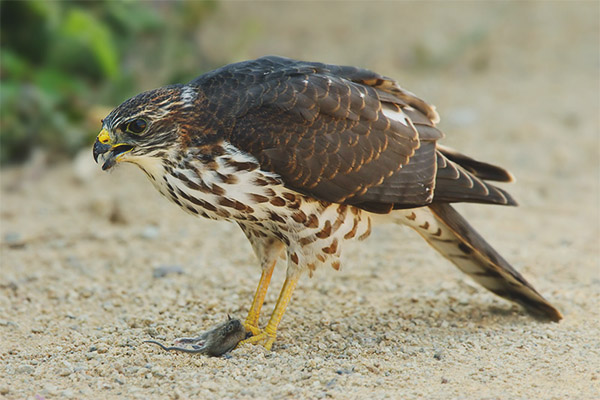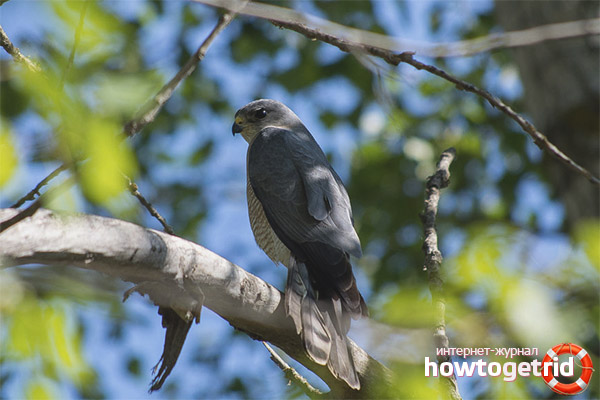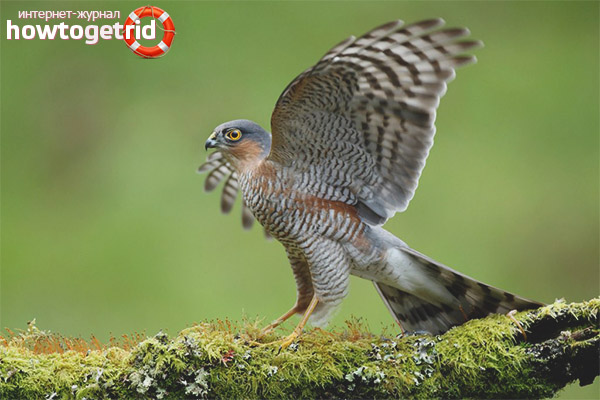The content of the article
Tyvik - predatory, day bird, belongs to the family of hawks. As a rule, they settle in the forests, closer to the water, because they prefer places with high humidity. The Tuvik received its name due to the characteristic cry, congruent with its name.
Tyuvik Description
Despite the fact that the bird is a predator, it is small, about like a dove. Depending on the species, it is found from 30 to 38 centimeters in length, and with a weight of no more than 250g. However, the wingspan can reach 80 cm. Unlike their relatives from the family of hawks, the female and male have almost the same size, but different colors.
The back and head of the male are distinguished by a light, gray plumage, and on the throat one can see a practically imperceptible transverse strip. The chest and neck are alternately painted in white and light red longitudinal stripes. Unlike the female, on the belly and tail of the tuvik horizontally thin and frequent.The ends of the wings are dark, with an average of 5-6 wide stripes. Undertail and underwing part are light, on the very tail from 5-7 lines.
The female has a darker plumage with a dash on the throat of a distinct dark color. The chest and neck are also decorated with horizontal stripes, but with a dark red tint.
Very often the bird is confused with a sparrowhawk, but, unlike the second one, the back of the tuvika is lighter, the head is gray without any inclusions, and there are no bright eyebrows. Legs and fingers are short, thick. Perepelyatnik, by the way, is much faster and more agile.
Young and adult birds differ in color. In young birds, the dorsal part is darker, instead of strips on the abdomen, there is a drop-like transverse pattern (in the future it will be transformed into lines), and a dark longitudinal strip on the goiter, like in females.
The eyes of birds of any age are of a dark color, with a red-brown iris, which particularly distinguishes them from other hawks.
Chuvik flies not quickly, but slowly hovers in the air in search of prey.
Bird food
During nesting, the male obtains food alone and feeds the female, in the autumn period they hunt in pairs.
The bird is rather secretive, however, it is often found on the territory of inhabited land, with an abundance of trees. There they hunt mice and moles.
In Asian countries with a large number of sparrows, tyvik help in the struggle to preserve the crop.
Types of Tyuvik
There are several species of this bird. The most common of them - European and Turkestan Chuvik.
- European. It has an average size of 30-38cm. The weight of the male does not exceed 190 grams. and the wingspan is 70, the weight of the female can reach 220 gr. It is less common than other species. The wings are sharper and longer than other subspecies. Color saturated reddish-brown. It lives in the southern regions of Russia, Armenia, Greece. In winter, flies to the countries of Egypt, Sudan and Iran. Migrates in large flocks.
- Turkestan Tyvik. Representatives of the male and female individuals of this species are similar to each other in the color of their plumage. However, the female is slightly larger than the male. The beak of birds is dark in color, with paws of characteristic yellow color. The back and wings are gray-brown, the ceramum is yellow with a brown tint. The length of the wings - 18-23 centimeters.In contrast to the European Tyuvik, has a larger size - up to 250 grams. And short legs. It nests in the countries of Central Asia, also in China, India, and Africa, Eritrea and Nigeria. It is found in Ukraine, the Caucasus and the Balkan Peninsula. As a rule, it does not fly away to distant countries for wintering, leads a sedentary lifestyle, preferring seasonal absences to the nearest areas.
- Nicobar Tyvik. This species of representatives of tyvikov lives exclusively in the forests of the Nicobar Islands, in the Bay of Bengal, in India. Treats the small, protected birds. The color of the Nicobar Tyuvik is similar to the European species.
Distinctive features of the female from the male
In addition to the color of plumage, individuals differ slightly in size. The female tyvik more by 30-50 grams. Males are more light and gray tones, while females are characterized by red and brown plumage, and a sharply defined strip on the throat.
Breeding birds
Tyvik arrive quite late, in comparison with other migratory predators, in late April, early May. They begin to nest in secluded places, exclusively on tall trees up to 30 meters (elm, alder, wind, poplar).The average size of the nest building is 40 cm in diameter and 20 in height.
If there are other nests close to this subspecies, birds can attack each other, therefore, as a rule, they do not allow a neighborhood closer than 1 km. They build their houses not dense, but large, in shape resembling an inverted cone. They line not only with branches and twigs, but also with grass and dry leaves. Unlike the sparrowhawk, in the nest there must be green leaves, according to which ornithologists immediately notice the habitat of the Tuvik. Very rarely, they capture the nests of other birds, for example, forty.
By the end of May - the beginning of June, the breeding season begins. The female lays no more than 4 eggs of white color, without any spots, but the closer the moment of nestlings appearance, the more the egg turns yellow. The incubation period lasts 33-35 days from the moment the first egg is planted.
Nestlings are in the nest up to 1.5 months of age, during which time their plumage replaces its white with a yellowish tinge. Toward the end of the summer, they leave the nest and often become prey of the Goshawk. The first two weeks the chicks are near the nest, feeding on insects and lizards.Already with the first cold, young birds fly to warm countries for wintering.
Puberty occurs in the first year, the average life expectancy of 10-12 years.
Tyuvic distribution
The bird's habitat is a forest and steppe zone. The forests are not thickened, light, near rivers and lakes, as well as fields.
The countries inhabited by the Tyvik are Eurasia, Ukraine and the Urals, Central Asia, Turkey and the Caucasus. Thuvik hibernate in African countries, and return to their homeland at the time of foliage appearance.
Number of
In the second half of the 20th century, the construction of hydropower stations on the Volga and Don rivers greatly influenced the number of packings. Flooded wooded areas, cutting down trees in the armholes of the rivers, led the usual places of settlement and nesting of birds to unsuitability, as a result of which the bird population sharply decreased.
In the past few decades, predatory goshawks, which prey on the Tyvik, have been actively breeding in the forest and steppe zones of Russia.and in the future can also significantly reduce their livestock. To date, there are about 50,000 birds, the species is listed in the Red Book.
Video: Tuvik (Accipiter brevipes)













To send